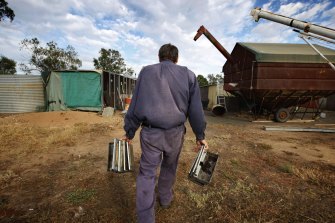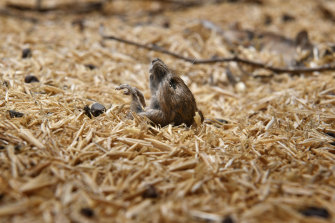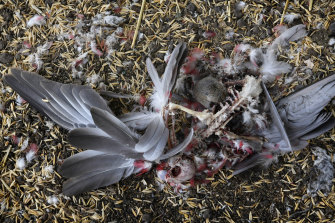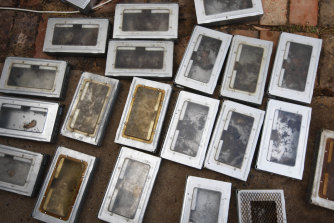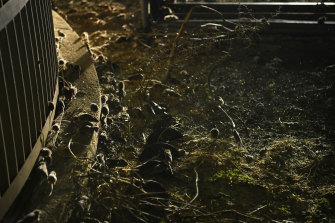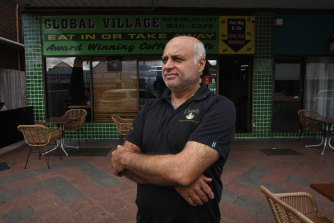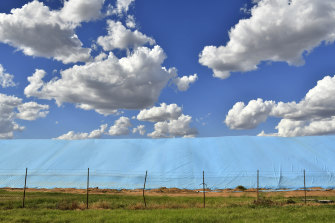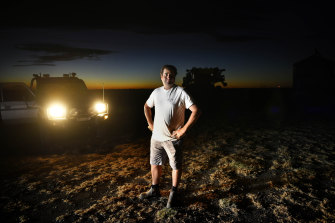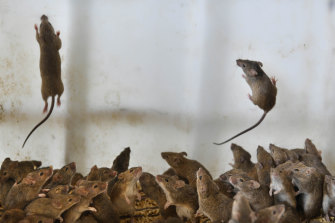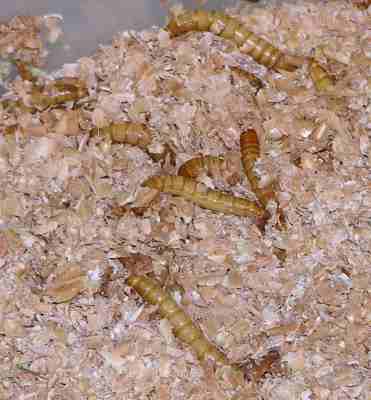Normal text sizeLarger text sizeVery large text size
Since December, Coonamble farmer Allan Inglis has been mired in a battle against a plague of mice that threatens to engulf much of NSW’s Central West grain belt.
Elevated mouse populations have been recorded from central Queensland down to northern and central NSW and into western Victoria. The boom has been fuelled by drought-breaking rains, bumper crop yields and an unseasonably mild winter. The mice are wreaking financial havoc, too. Inglis says that by winter, he will be up to $500,000 out of pocket.
Coonamble broad acre farmer Allan Inglis cleaning out his traps. Credit:Dean Sewell
The second-generation broadacre farmer has been locked in a grisly daily ritual of collecting and emptying the mouse traps he has set the night before around his homestead.
Like most farmers, Inglis, 57, uses industrial-grade traps. “I bought them from China on eBay, I got them for $7, but now they are asking $14,” he says. “But right now, I’m only using them around the house and some around the chickens. We’re just trying to keep them out of the house but they are eating through everything; the door frames, the internal insulation, even the concrete around the homes’ footings.”
Mice start breeding at six weeks of age and can have a litter every 21 days after that, meaning a pair of mice can give rise to 500 offspring in a season.
“I would rather a locust plague over a mice plague,” says farmer Allan Inglis.Credit:Dean Sewell
Inglis sets off on his morning patrol, picking up the traps, one atop another before the weight forces him to set them down around a large plastic tub full of water.
He’ll make several more trips to collect the two dozen or so traps he has placed around his home. The perforated steel traps make for easy disposal of the captured pests and it is his preferred method. “It’s quick and the most humane way of killing them,” he says. ”The manufacturers say you can catch 30 at a time, but I’m getting more than 60 on some days.“
Inglis collects his industrial-grade perforated steel traps, then submerges them in water to drown the rodents.Credit:Dean Sewell
Inglis then submerges the traps into the tub with methodical precision, drowning the mice. It’s a procedure he has streamlined over the summer months and one he will perform several times to dispose of the hundreds of mice he has captured.
Once this macabre spectacle is over, Inglis carries the containers of dead mice to a paddock far beyond the homestead.
“Even the birds are getting sick of them,” he says, giving a nod to a confusion of wandering guinea fowl.
Asked to estimate the number of rodents he has caught, Inglis pauses. “Aah, let’s see. This morning I got around 500, but on others like yesterday, I got 800. Let’s say on average I get 500, well I’ve been trapping every day of every week for 10 weeks, so that’s like 35 … er thousand!”
“I’m going through half a kilo of peanut butter a week,” he says as he scrapes the remaining debris from his traps with his bare hands, the result of last night’s rodent haul, and mutters to himself “this just can’t be healthy”.
Masses of dead mice are found around the silos and throughout the grain and hay storage sheds due to poisoning. Credit:Dean Sewell
Inglis was born the son of a Walgett jackaroo who moved to Coonamble in 1962 and was 20 at the time of the 1984 mice plague, recognised as one of the worst in Australian modern history. His recollection of the time is still vivid.
“The ’84 plague was really bad but this one is worse. At least with that plague it was relatively brief, it was annihilated by the onset of winter rains and cold. This one is just lingering and unless we get a good weeks’ rain and a decent cold snap, it’s going to be with us for some time yet,” he says.
Beyond the well-watered lawn and country garden that the Inglises maintain, is a 300-tonne haystack that is disintegrating from the bottom up. A now common sight along the Castlereagh Highway from Gilgandra to Walgett, they serve as a striking testament to the mice’s ravenous quest to multiply as they eat their way across inland NSW.
The mice eat through anything including grain, fallen galahs, hay and the electrics of machinery. Credit:Dean Sewell
The mice seek out the grain within the bales of forage sorghum being stockpiled as cattle feed. They establish high-rise-style apartment living where they can feed on the protein-rich grain and breed uninterrupted.
“Have a look at that hay. It’s ruined. You can’t feed that to the cattle because it will kill them. It’s soiled,” Inglis says. “I’m now trying to work out if I can work it back into the land in any meaningful way, or whether I’ll just have to burn it.”
This is the dilemma for many farmers across the district.
Inglis forecasts that by winter, he will be out of pocket by up to $500,000.
In an adjacent paddock from his infested haystacks, Inglis’ current crop of sorghum has nearly been destroyed by the vermin. “They’ve gotten into the sorghum, too. They’ve stripped the heads and they are even eating the leaves from it.“
Farmer Allan Inglis has caught and disposed of an estimated 35,000 mice in 10 weeks.Credit:Dean Sewell
Like most farmers, Inglis knows the rain forecast and predicted percentages for the entire week. He can rattle them off without a second thought, yet he is not encouraged by the patchy and isolated rain cells that were part of a weak change moving across the district.
“Oh, we’ll miss out again, that’s normal, it’s always going around us,” he says as he glances across his sorghum crop. ”One fella over there just put 160 hectares of sunflower seeds in and already he has lost 60 hectares.
“You can hardly get the seeds in the ground before the mice have gotten to them. I would rather a locust plague over a mice plague. At least you can spray a locust plague and knock it out from the air, but these little buggers live underground and you can’t get to them.
“We also pay a levy in our rates that ensures that we get the pesticides from the land councils to deal with locusts, but there are no provisions for mice.
The ground swarms with mice on the property of Coonamble broad acre farmer Jason Hogland. The mice congregate at night at his wheat storage silos. Credit:Dean Sewell
“They are eating through our crops, they are destroying the hay we are putting aside for worse times and they’re getting into the electrical wiring of our tractors and harvesters. It’s going to cost us an arm and a leg.”
Ahmad (Al) Karanouh is the sprightly and enthusiastic mayor of Coonamble.
He runs a cafe on the main street. In between taking orders and serving breakfasts, he is also frantically working his phone, flitting between the shop and the sun-drenched pavement.
“I am really concerned for the mental well-being of our farmers and townspeople,” Karanouh says. “This plague is really taking its toll on our people. The hairdresser next door is 80 years old and she came to me the other day and said ‘Al, I simply can’t do this anymore, I don’t know how I’m going to cope’. That is what we are having to deal with.
Coonamble mayor Ahmad Karanouh in front of his cafe on Castlereagh Street.Credit:Dean Sewell
“We have had one good year after three years of backbreaking drought. Now we seem to be back to where we started. Mentally, it’s very challenging.”
In the gutters outside of Karanouh’s cafe and along the main street, there are dead mice from the nightly baiting program.
In early February, the NSW Environmental Protection Authority reported “several recent poisonings” from a mouse bait product not designed for use in homes containing zinc phosphide, which it said resulted in hospitalisations.
There were reports of the zinc phosphide-based rodenticide being used in household airconditioning vents and roof cavities which could lead to phosphine gas poisoning.
The EPA has offered a clean-up service for the baits and its officers were in Coonamble last week to talk to the community about the issue.
Loading
Karanouh says residents are “desperate” and wants government assistance to control the mice plague.
“People have become so desperate; the supermarkets and other stores have run completely out of mouse traps and domestic baits. When people get this desperate they will resort to anything,” says Karanouh. “The supermarkets are under attack, as are all of our shops and business. It seems there is not much more we can do than lobby.
“I’ve talked with other mayors in the region, from Walgett to Warren and we have written letters to both the state and federal agricultural ministers. What we need is for the governments to officially declare the situation a plague. They don’t want to because if they do, they might have to look into financial compensation packages. What we need is for our governments to stand up and help our farmers.”
NSW Farmers’ Coonamble branch chairman James Nalder says the times ahead are going to be challenging. “People out here are getting pretty desperate. In some of the older homes where the seals are not so good, they are catching 40 plus mice a day, but the real concern is amongst some of the smaller farmers,” he says.
“Anyone who still has temporary grain storages on their land are getting them up off the ground and into silos where it is much safer. No matter how much baiting they are doing; killing 30,000 or more, they are still inviting another 90,000 to the funeral.”
Nalder says farmers from Queensland, through NSW and into Victoria are comparing the current plague to that of the 1984 event.
Wheat is stored under tarpaulins at GrainCorp’s Coonamble facilities.Credit:Dean Sewell
“In September of last year, we were baiting up in Queensland. It’s been a slowly creeping pest, moving its way south,” he says. “We are seeing it in Mudgee and Dunedoo regions, Parkes and Forbes too, and now as far as the Riverina and into the Wimmera in Victoria.”
As the current plague threatens post-drought recovery across NSW, the economic damage it seems is difficult to calculate. “The real costs will only be measurable by the next drought,” says Nalder. “I’m now hearing stories of farmers having to burn their hay stocks that have been stockpiled in some cases for years down the track when the next drought arrives. While the current price may be around $200 per tonne, that could easily shoot up to $600 by the time they are forced to buy it back in.”
Jason Hogland is another farmer from Coonamble. His primary crops are wheat, barley, oats and chickpeas and he also runs cattle.
Jason Hogland on his property, several kilometres from Coonamble. Credit:Dean Sewell
Under the midday sun, the air around Hogland’s grain silos is stiflingly acrid from the bloated and decomposing bodies of thousands of dead mice. “I started baiting in the second week of January and I’ve been baiting ever since, every three days or so,” he says.
Hogland is already budgeting for the costs of baiting as they approach a crucial time of year when farmers are preparing to sow their winter crops from April.
“We’ll go ahead with wheat, barley, oats and chickpeas, but we are concerned about the mice. We’re considering baiting the fields six weeks before sowing, then we will follow it up immediately with another baiting. The little buggers will follow the plough, so yeah, we are budgeting around $40,000 to $50,000 for baits.”
Hordes of mice are laying waste to crops across central NSW.Credit:Dean Sewell
Loading
Hogland has agreed to meet at the silos after dark. Standing in the pitch black with only the lights of his 4WD, we hatch a photographic plan of attack.
“I will take the vehicle around the back over there and hit the floods when I come around to the silos. You will see them scatter,” says Hogland. Under the strength of his headlights, the night ground begins to come to life as the mice start pouring in from the fields. “See,” Hogland points, “here they come for the grain.”
To the distant north-east, huge columns of cumulonimbus clouds put on a spectacular display of lightning but they are all show for now. “We need Mother Nature to bring ’em into line,” Hogland says as any hope drifts further away, across the Pilliga and on into Narrabri.
Start your day informed
Our Morning Edition newsletter is a curated guide to the most important and interesting stories, analysis and insights. Sign up to The Sydney Morning Herald’s newsletter here, The Age’s here, Brisbane Times’ here, and WAtoday’s here.
Dean is an award winning documentary photographer.
Most Viewed in National
Loading

